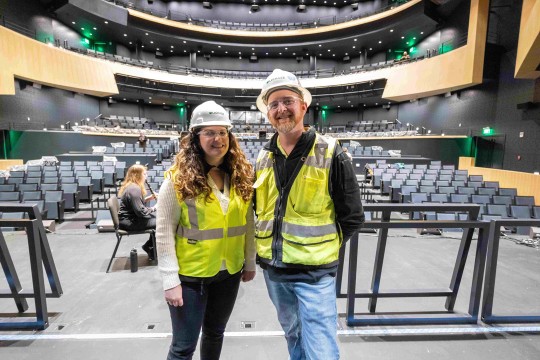Building the SHED: A Q&A with RIT registrar Joe Loffredo
The Student Hall for Exploration and Development (SHED) and the renovated Wallace Library will reopen in less than a year with new classrooms that will fill the upper floors of the buildings and a portion of the combined A-level. Work has begun to schedule the fall semester classes that will be held for the first time in the SHED complex, and Joe Loffredo, RIT associate vice president for Academic Affairs and registrar, is leading the effort to assign the classrooms in Wallace Library.
Christine Licata, associate vice provost, leads the overall SHED planning effort, and Loffredo has played a role on the teams focused on classroom utilization and the reallocation of classrooms for research space. Loffredo and Sandi Connelly, principal lecturer in the Thomas H. Gosnell School of Life Sciences, who is scheduling the SHED classrooms, are collaborating with the colleges’ associate deans and scheduling officers to finalize room assignments for the fall 2023 class schedule. The fall schedule will publish in March ahead of open registration in April.
The centralized classrooms in the SHED complex will represent shared space among the colleges. The new learning spaces include 22 regular-sized classrooms in Wallace Library and five extra-large rooms in the SHED, some of which can seat up to 150 students, or approximately three-to-five sections of a multi-section class. New classroom technology and movable whiteboards and furniture will give instructors flexibility to shape their different learning spaces and engage students in small-group learning.
The SHED complex is the future creative hub envisioned by RIT President David Munson to display the unique culture at RIT that blends technology, the arts, and design. The building will include the Brooks H. Bower Maker Showcase, the Sklarsky Glass Box Theater, music and dance studios, and the new classrooms.
Here, Loffredo talks about working behind the scenes on the SHED complex.
What are the challenges to scheduling classes in the SHED and in Wallace Library?
We want faculty who teach classes that can make use of the technology and the additional space.
Each college has a scheduling officer, and they work with their academic departments and leadership to schedule classes in the rooms they control, such as labs, conference rooms, and specialized classrooms—and general purpose classrooms that we allocate for their priority scheduling.
This is going to be a big challenge for them because they are gaining and losing classrooms. They are losing some traditional compact rooms and getting some flexible larger rooms in terms of square footage per student. And we’re going to work with the colleges and scheduling officers to prioritize the Wallace classrooms within their own scheduling.
How are the new classrooms different?
We (Office of the Registrar) have always played a role in supporting the colleges in scheduling classrooms, but the type of classrooms in the SHED are completely different. They are more flexible, more immersive.
Both the SHED and Wallace rooms are unlike anything we have on campus in terms of square footage per student. As RIT grew, we needed to put more students in a classroom, and now we have 17-to-19 square feet per student in our regular classrooms on average. In the Wallace classrooms, we are going to have about 25 square feet per student with furniture that is completely movable. Everything is on wheels. The rooms can be adjusted, reconfigured. In Wallace, we’re going to have 22 classrooms, each of which could be used for active or flexible classrooms.
The five classrooms in the SHED will be large-scale rooms seating up to 150 students. A practice room, called the beta SHED room, was created in Slaughter Hall this year to give instructors experience teaching on this scale, and the Center for Teaching and Learning is offering workshops for faculty to learn new teaching strategies and the TeachSHED website. How else have you prepared faculty for this culture change?
I’ve collaborated with Sandi Connelly, Neil Hair, Ian Webber, Christine Shank, and Christine Licata—who has been involved with every single part of the project—for the last two years on the SHED Classroom Utilization Team. We’ve been working toward getting the faculty and the campus ready for these brand new spaces. This has meant getting the faculty to work together and trying to get the colleges to re-envision their courses and use the new technology that will be a huge part of these classrooms, as well. There is more technology in these rooms than any room we have on campus. There are projection screens on nearly every wall in the SHED rooms (and projectors in the ceilings), for instance, and places for every student to plug in their devices.
The new learning spaces in the SHED and in Wallace Library will free up existing classrooms for research space. How will the room exchange affect scheduling for the fall?
Ryne Raffaele oversaw the Classroom Space Exchange and Research Space Re-allocation Committee that reviewed requests and prioritized which colleges would get how much research space in the exchange. Facilities Management Services is developing a plan for how quickly the research space will be converted. Our approach is to assume these rooms are going offline in the fall, and we’ll have use of the new rooms in the SHED and Wallace.
I worked with the research exchange group to identify the rooms that could potentially be converted for research. Then, I worked with the president and the provost to determine how much space and which rooms should be reallocated. Now, I’m communicating that to the colleges and the scheduling officers and assigning priority to the Wallace rooms.
What has it meant to you to be part of the SHED planning team?
When these kinds of projects come along they are reinvigorating because it’s new work and brand new for RIT. It’s the epitome of RIT because it’s cross-divisional and cross-college, and you work with people you probably never would have worked with before.



